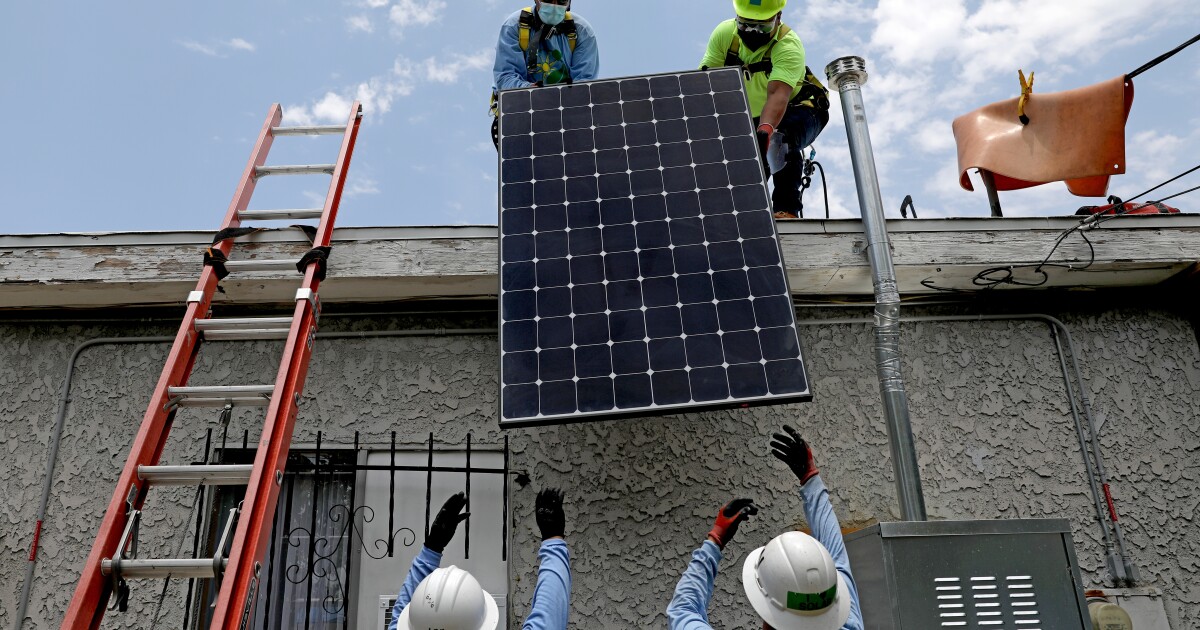
Parakeets and lovebirds had been chirping in Marta Patricia Martinez’s frontyard as a workforce of photo voltaic installers climbed onto her roof.
It was once a heat summer season afternoon in Watts, a predominantly Latino and Black community in South Los Angeles. Low-income households confronted the threat of punishingly top power expenses in the event that they cranked up the air-con.
For Martinez, photo voltaic panels introduced an almost-too-good-to-be-true resolution.
Her electrical energy expenses would most probably drop by means of about 90%. And her kin was once getting the blank energy machine unfastened, because of state investment secured by means of GRID Choices, the Oakland nonprofit putting in the rooftop panels.
“Sun’s no longer about the next day to come. It’s about nowadays,” mentioned Darean Nguyen, a manager at the set up workforce.
However at the same time as the warmth waves and wildfires of the local weather disaster irritate — and as monopoly software corporations combat to stay the lighting on — Gov. Gavin Newsom’s management may quickly make it tougher for lots of households to move photo voltaic.
State officers were laying the groundwork to slash a key photo voltaic incentive program referred to as web power metering, with a call anticipated this 12 months. This system’s critics — together with software giants, ratepayer watchdogs and a few environmental justice activists — insist web metering is basically inequitable, widening the space between wealthy and deficient.
Sun corporations and plenty of local weather activists disagree. They are saying gutting incentives may motive installations to plummet on single-family houses, condominium structures, companies and colleges.
“We will be able to fall horribly wanting our blank power targets if we kill the rooftop photo voltaic marketplace,” mentioned Bernadette Del Chiaro, govt director of the California Sun & Garage Assn. “Sun goes to return to the time when it’s just for the tremendous rich.”

Karena Massengill attends a protest hosted by means of the Sun Rights Alliance outdoor a Southern California Edison workplace in Lengthy Seashore on Nov. 1.
(Robert Gauthier / Los Angeles Instances)
A sour combat over the deserves of rooftop photo voltaic would possibly appear wildly misplaced in eco-friendly California.
However the struggle strains aren’t so simple as local weather champions on one aspect and science deniers at the different. The talk has raised thorny questions on financial and racial justice and gotten knotted up within the third-rail politics of arranged exertions.
It has additionally uncovered diverging visions of the blank power long term: One by which society is most commonly powered by means of rooftop photo voltaic panels, and some other by which the software electrical grid maintains its dominance, with far away photo voltaic farms changing far away coal vegetation.
Each applied sciences will probably be had to confront world warming. However the stability that’s in the end struck — between sprawling power infrastructure protecting massive quantities of land, and what rooftop photo voltaic advocates name “power democracy” — will assist decide who can pay and who income, and what The us looks as if when the mud settles.
Right here’s what’s at stake
Web power metering has helped make California a photo voltaic powerhouse, with greater than 1.3 million programs put in.
This system works by means of crediting solar-powered houses and companies for the electrical energy they export to the software grid. They nonetheless need to pay for electrical energy they draw from the grid when photo voltaic isn’t sufficient. However the credit decrease their per thirty days expenses.
Web metering doesn’t pencil out for everyone — going photo voltaic can price tens of 1000’s of greenbacks, and it’s incessantly no longer imaginable for renters. However for many who will pay or qualify for a mortgage, the affordability of photo voltaic in most cases comes all the way down to the “payback duration” — the collection of years it takes to make again their funding thru decrease electrical expenses.
The common house served by means of Southern California Edison could make again its photo voltaic funding in 5 years, in keeping with an research by means of consulting company E3. Underneath the software business’s proposed adjustments to web metering, that might develop to 17 years for brand new photo voltaic adopters served by means of Edison and 21 years for the ones served by means of Pacific Gasoline & Electrical — making photo voltaic a more difficult monetary elevate.
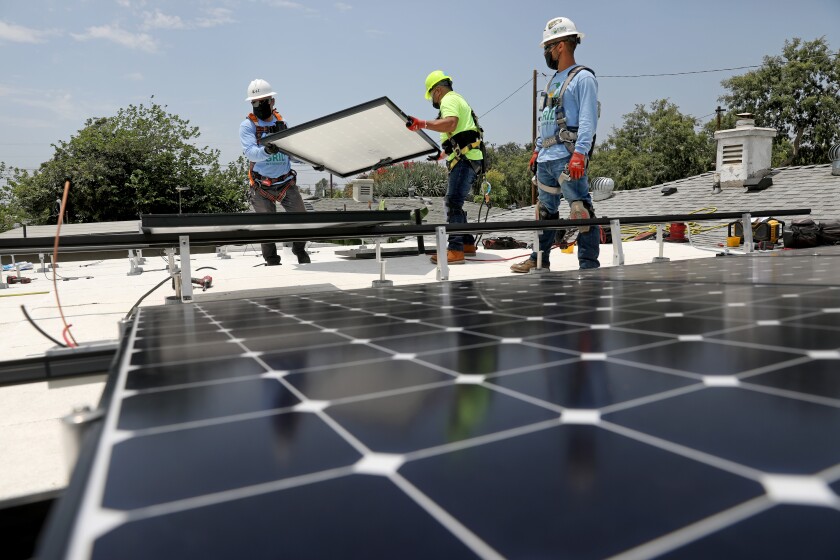
A workforce from GRID Choices installs photo voltaic panels at Marta Patricia Martinez’s house in Watts.
(Gary Coronado / Los Angeles Instances)
Rooftop photo voltaic proponents are satisfied that Edison, PG&E and San Diego Gasoline & Electrical are motivated by means of cash.
The corporations don’t make a benefit on electrical energy gross sales, however they do generate really extensive returns for his or her shareholders after they construct transmission strains and different infrastructure. The continuing expansion of rooftop photo voltaic threatens that industry type, critics say.
“The utilities have cooked up a PR marketing campaign to persuade everyone that their manner is the awesome method to move,” Del Chiaro mentioned.
The argument towards web metering is going like this: When photo voltaic houses decrease their power expenses, software corporations accumulate much less income. Consequently, state regulators don’t have any selection however to allow them to carry electrical energy charges for everybody, to assist pay for tasks comparable to hardening energy strains to stop wildfire ignitions and putting in batteries to stay the lighting on after darkish.
And since photo voltaic consumers are wealthier than the inhabitants as an entire, web metering works like a subsidy from the deficient to the wealthy, the coverage’s critics say. The amount of cash transferred from non-solar families to their net-metered neighbors quantities to $3.4 billion in step with 12 months in California, the software business estimates — a determine referred to as the associated fee shift.
“This system has to modify,” mentioned Caroline Choi, Edison’s senior vice chairman of company affairs. “It’s no longer sustainable when the parents who’re least ready to have the funds for it are subsidizing those that do find a way.”
The fee shift argument has additionally been trumpeted by means of exertions unions representing software employees, who’ve a vested hobby in protective their employers’ industry type. They are saying they’re looking to stay power inexpensive for everybody.
“In 2021, rooftop photo voltaic will take $3 billion out of the wallet of maximum California electrical consumers and put it within the pocket of a small crew of shoppers who’re in most cases richer, whiter and reside in single-family houses,” mentioned Marc Joseph, an lawyer representing the Coalition of California Application Workers and the California State Assn. of Electric Staff.
The Herbal Sources Protection Council, an influential environmental crew, has additionally sounded the alarm about the associated fee shift, calling for adjustments to web metering that might double the photo voltaic payback duration. Two revered client watchdogs, the Application Reform Community and California’s Public Advocates Administrative center, wish to see even better discounts to photo voltaic incentives.
All 3 are inquiring for adjustments that might result in upper per thirty days expenses for houses that have already got photo voltaic panels — in contrast to the software corporations, that have simplest proposed revamping web metering for brand new photo voltaic adopters.
“It is a critical injustice that we’re looking to proper,” mentioned Matthew Freedman, an lawyer on the Application Reform Community.

Bernadette Del Chiaro, govt director of the California Sun & Garage Assn., celebrates the state achieving its millionth photo voltaic roof at an match at Buchanan Top College in Clovis in 2019.
(Tomas Ovalle / For The Instances)
Sun advocates counter that the era is getting inexpensive and is now not solely for the rich.
Knowledge from Lawrence Berkeley Nationwide Laboratory display that 12% of California photo voltaic adopters in 2019 had earning beneath $50,000, and an extra 29% had earning between $50,000 and $100,000 — up from 9% and 24%, respectively, a decade previous.
Sun installers and plenty of local weather activists see the associated fee shift argument as a farce.
They are saying utilities are undercounting the financial savings that rooftop photo voltaic brings to all Californians by means of proscribing the desire for pricey new energy vegetation and transmission strains — to not point out the well being advantages of much less air pollution from burning fossil fuels. In addition they say rooftop photo voltaic paired with batteries can function a backup energy supply when utilities close off electrical energy to prevent their apparatus from sparking wildfires — or when fires, storms and different climate occasions exacerbated by means of local weather trade knock out the grid.
Analysis from Colourful Blank Power backs up the ones claims.
With investment from photo voltaic advocates and installers, the consulting company discovered that almost getting rid of U.S. local weather air pollution can be $473 billion inexpensive with dramatic expansion in rooftop and group photo voltaic and batteries. California specifically may save $120 billion by means of construction out six instances the volume of small-scale photo voltaic put in nowadays, together with a lot of batteries, Colourful estimated.
“We’re going to wish loads of 1000’s of megawatts going onto the grid [nationally] by means of 2050 it doesn’t matter what we do,” mentioned Colourful Leader Govt Chris Clack, an power programs researcher. Construction a lot of rooftop photo voltaic “makes it more uncomplicated and less expensive.”
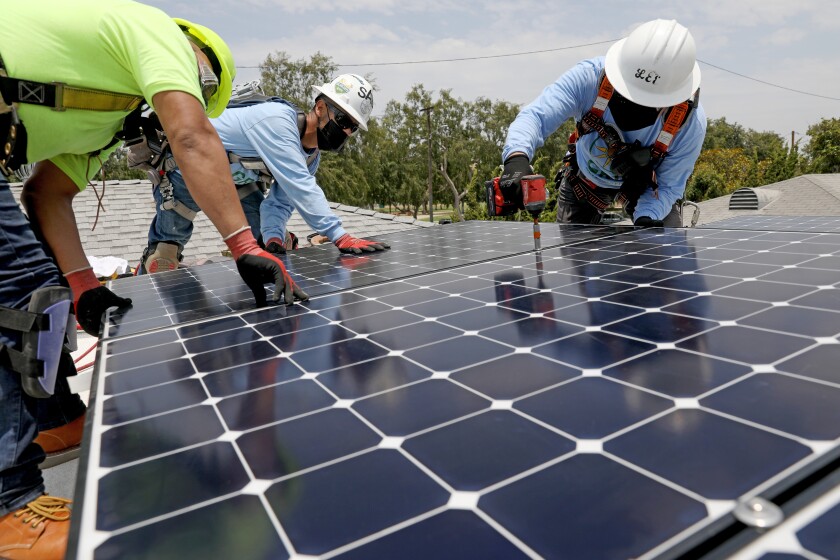
GRID Choices photo voltaic installers Juan Alcantara, left, Sal Miranda and Lee Kwok position rooftop panels on Marta Patricia Martinez’s house in Watts.
(Gary Coronado / Los Angeles Instances)
A bruising political struggle
Now not all researchers believe that evaluate.
UC Berkeley power economist Severin Borenstein — who leads an institute that receives small quantities of software investment — mentioned Colourful’s fashions exaggerate the case for rooftop photo voltaic. Borenstein has written that web metering “hurts the deficient. It’s that straightforward.”
State officers appear sympathetic to that argument.
The California Public Utilities Fee — which can come to a decision what adjustments, if any, to make to photo voltaic incentives — not too long ago cited web metering as certainly one of a number of components riding up electrical energy charges. The prices of the photo voltaic program are “disproportionately paid by means of more youthful, much less rich, and extra deprived ratepayers, a lot of whom are renters,” fee group of workers wrote.
State Assemblymember Wendy Carrillo, a Los Angeles Democrat, pressed fee President Marybel Batjer on web metering this summer season, asking why the company hadn’t but addressed the associated fee shift. Batjer stated “the inequity or the prejudice of the present construction” and promised a call at the program’s long term quickly.
Carrillo was once certainly one of two lawmakers at the back of Meeting Invoice 1139, which might have forced the utilities fee to take a cudgel to web metering. The invoice failed within the face of livid opposition from atmosphere activists and photo voltaic corporations, however no longer sooner than a showdown at the Meeting flooring that noticed 27 lawmakers vote to slash photo voltaic incentives — they all Democrats.
Why was once there such a lot give a boost to for the invoice? Partially as it was once subsidized by means of politically robust arranged exertions.
It’s no longer simply software staff preventing to undercut rooftop photo voltaic incentives. Union electricians want massive photo voltaic farms as a result of they’re in most cases constructed by means of union exertions in California, in contrast to rooftop panels, which might be put in most commonly by means of nonunion employees.
The invoice’s different writer, Assemblymember Lorena Gonzalez, bristled at accusations of being a stooge for arranged exertions. The San Diego Democrat, a former union organizer, at one level referred to as her critics “self-proclaimed ‘environmentalists.’” When a political marketing consultant tweeted that her invoice was once “an influence & cash seize of huge utilities,” she answered, “Don’t parrot company photo voltaic.”
“What I’m looking to do is decrease the charges of nearly all of my constituents, 99% of them,” Gonzalez mentioned in an interview.
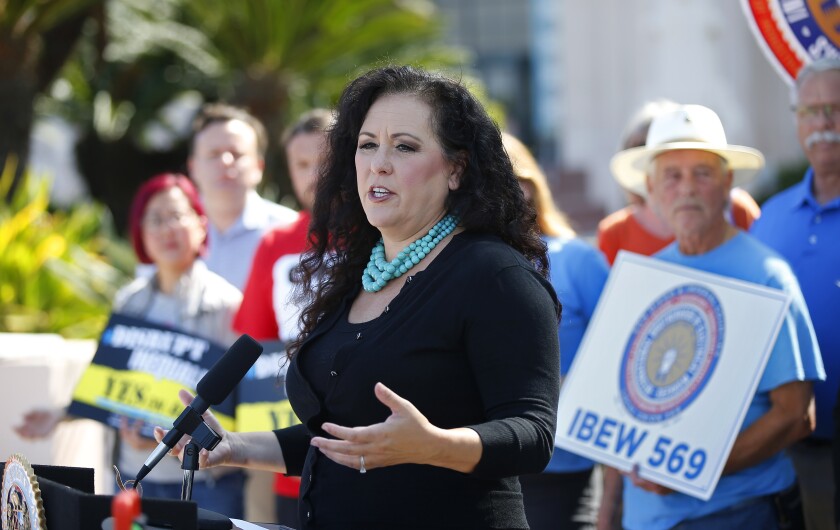
Assemblymember Lorena Gonzalez speaks at a information convention in 2019 with participants of IBEW Native 569, a union representing electric employees in San Diego and Imperial counties.
(Okay.C. Alfred / San Diego Union-Tribune)
The sparring isn’t any much less fierce now that the talk has moved to the Public Utilities Fee.
Events on each side, from the photo voltaic business to the utilities, say their web metering proposals would assist low-income households. Or even this system’s most harsh critics say rooftop photo voltaic should continue to grow in California for the state to fulfill its local weather targets.
However accusations of dangerous religion have run rampant.
The Sun Rights Alliance, for example, accused the Application Reform Community of “the use of their recognition to assault rooftop photo voltaic” and “selling false claims.” The shopper watchdog’s govt director, Mark Toney, answered that his group “is a pace-setter in preventing software fee will increase and supporting a fast transition to a blank power economic system.”
Different photo voltaic supporters created a petition slamming the AARP for “pushing the utilities’ schedule.” AARP has defended its advocacy.
Requested in regards to the Herbal Sources Protection Council’s plan to overtake web metering, the photo voltaic business’s Del Chiaro instructed the environmental crew has too shut a dating with software corporations to be relied on. She pointed to NRDC’s historical past of collaboration with the Edison Electrical Institute, a industry affiliation for investor-owned utilities together with Edison and PG&E.
NRDC senior scientist Mohit Chhabra mentioned the crowd’s paintings is unbiased of the software business.
“We wish to transfer towards a spot the place we incentivize rooftop photo voltaic predominantly for low- and middle-income Californians, and we additionally incentivize hanging rooftop photo voltaic and garage in the suitable puts at the grid,” Chhabra mentioned in an interview.
Two visions of environmentalism
Underneath the political and technical disputes is a stark philosophical divide.
At one finish are environmentalists who deeply distrust giant utilities and assume common other folks have a proper to generate their very own energy. Some are conservationists who don’t wish to see large photo voltaic farms disrupt delicate ecosystems and scenic landscapes.
“Dispensed photo voltaic is this kind of no-brainer — to place your photo voltaic proper there and percentage it along with your neighbors,” mentioned Sara Lee, a instructor and activist who helped arrange a protest of Meeting Invoice 1139 outdoor Carrillo’s Echo Park workplace.
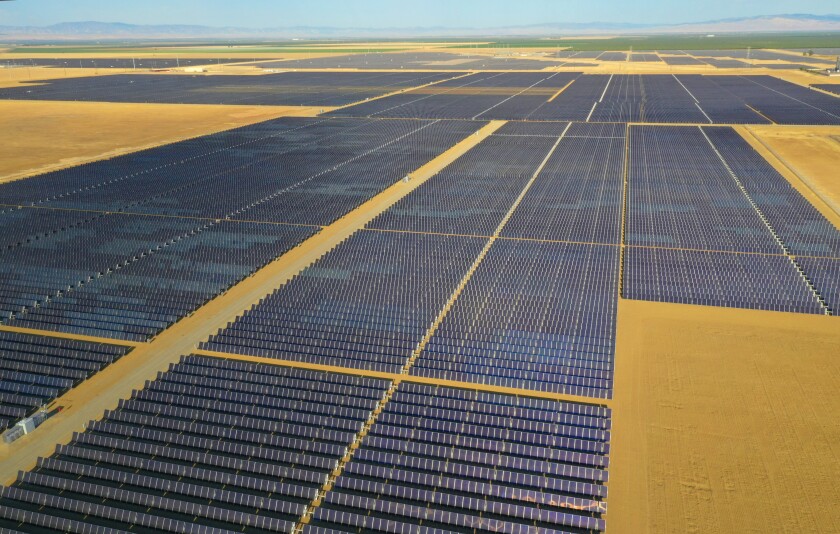
Westlands Sun Park within the San Joaquin Valley may sooner or later duvet greater than 20,000 acres.
(Carolyn Cole / Los Angeles Instances)
On the different finish of the divide are environmentalists who see current establishments — together with giant firms and the software grid — because the quickest, very best method to take on world warming. They agree that rooftop photo voltaic is necessary for decreasing emissions but in addition cite analysis appearing it’s dearer than massive photo voltaic farms, which have the benefit of economies of scale.
To Borenstein, the truth is that photo voltaic houses nonetheless rely on software poles and wires, since they export energy to the grid at sure instances of the day and draw energy from the grid at others. With web metering, he mentioned, they’re “unfastened driving at the machine.”
Borenstein and different critics say web metering may in fact harm California’s local weather quest by means of riding up power prices. Maintaining energy inexpensive is an important to persuading extra other folks to shop for electrical vehicles and set up electrical warmth pumps of their houses — key methods for decreasing local weather air pollution, and in addition an enormous alternative for electrical utilities to develop their gross sales.
“Our industry technique is tied to the targets of the state,” Edison’s Choi mentioned.
To turn grass-roots give a boost to for his or her rooftop photo voltaic stance, the utilities introduced the Reasonably priced Blank Power for All marketing campaign, which has attacked web metering. The marketing campaign lists greater than 100 supporters, together with the California Latino Management Institute, the Heart for Asian American citizens United for Self Empowerment and the Sacramento Black Chamber of Trade.
However two-thirds of the ones supporters won investment from Edison, PG&E, SDG&E or SDG&E sister corporate Southern California Gasoline Co. closing 12 months, or recently checklist a sponsorship from a type of utilities on their web site, a Instances research discovered.
Kathy Fairbanks, a spouse on the public members of the family company operating the marketing campaign, mentioned in an e mail that every crew “weighed the [solar] coverage on its deserves and concluded it wishes reform.” Nonetheless, she stated the utilities are the marketing campaign’s simplest funders.
“The photo voltaic business has additionally employed PR corporations, similar to ours,” she mentioned.
Sun advocates say they’re those with true grass-roots give a boost to on their aspect. About 350 teams — together with organizations involved in local weather motion, public well being, conservation and equitable housing — are a part of the Save California Sun marketing campaign, which has won photo voltaic business investment and is urging the Public Utilities Fee to offer protection to web metering.
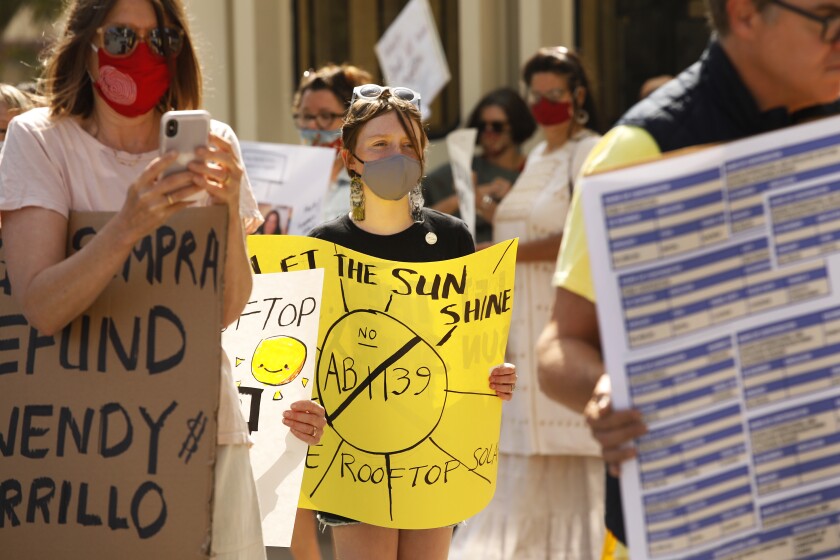
MJ Wodkowski, 11, middle, joins her mom, Jessica Craven, left, at a protest of Meeting Invoice 1139 outdoor state Assemblymember Wendy Carrillo’s Echo Park workplace in June.
(Al Seib / Los Angeles Instances)
Who can pay, and who income
As the web metering debate nears its endgame, main environmental justice advocates are moderately weighing in.
Teams together with the California Environmental Justice Alliance and Management Suggest for Justice and Duty mentioned in a September commentary that the photo voltaic program “disproportionately advantages wealthier, white, single-family house owners.”
However they didn’t take a place at the price shift query. As an alternative, they introduced concepts for serving to low-income renters and other folks of colour have the benefit of blank power, comparable to construction “group photo voltaic” amenities that serve complete neighborhoods.
Sun incentives, they wrote, should “prioritize the desires of the communities maximum harmed by means of historical air pollution.”
“There’s an pleasure about photo voltaic, particularly a number of the people we paintings with. However there’s numerous give a boost to wanted,” mentioned Amee Raval, coverage and analysis director at Asian Pacific Environmental Community, one of the most teams at the back of the commentary.
Fortify our journalism
Your give a boost to is helping us ship the scoop that issues maximum. Subscribe to the Los Angeles Instances.
Different environmental justice activists are protecting web metering. The newly shaped Coalition for Environmental Fairness and Economics, which has won investment from Save California Sun, despatched Newsom a letter accusing the utilities of “race-baiting.”
“We need to inform the reality, which is that [rooftop solar] is and will also be readily to be had for many communities,” mentioned the Rev. Ambrose Carroll, founding father of Inexperienced the Church and one of the most fairness coalition’s leaders. “We need to combat for it.”
Regardless of the Public Utilities Fee makes a decision, going photo voltaic gained’t be as simple for most of the people because it was once for Marta Patricia Martinez, as a result of most of the people gained’t have their prices lined by means of a nonprofit comparable to GRID Choices.
However GRID technique officer Danny Hom, status in Martinez’s Watts yard, mentioned web metering is an important for low-income houses.
Households comparable to Martinez’s, he mentioned, are not going to look vital price financial savings from photo voltaic with out some model of this system.
“We see at all times how that is transformative for other folks,” he mentioned. “What I pay attention so much, particularly because it will get scorching, is, ‘I don’t wish to run air-con as it’s too pricey.’ In numerous instances, older other folks’s electrical energy utilization would possibly in fact move up when they get photo voltaic, as a result of they’re ready to do issues which can be relaxed for themselves with out being concerned that they’re going to spend $300.”
As for Martinez? She mentioned she deliberate to make use of the photo voltaic financial savings for her first go back and forth house to Guatemala in additional than a decade.
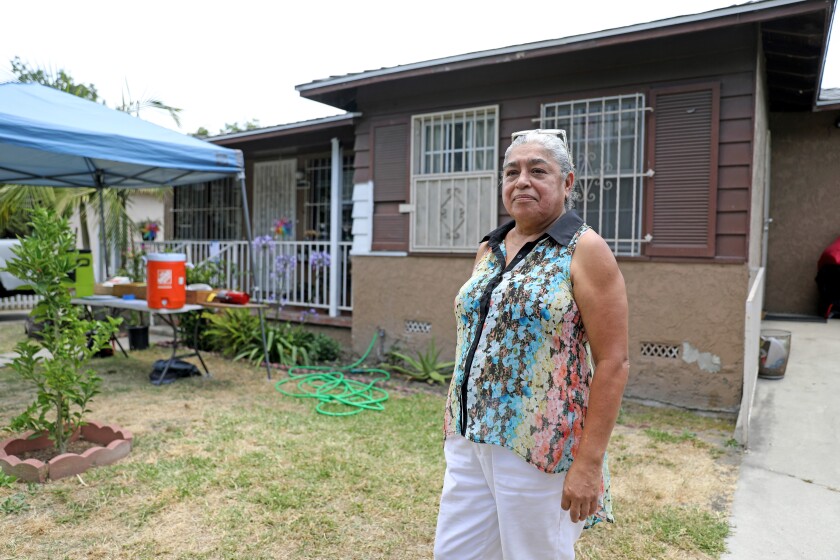
Marta Patricia Martinez, 64, stands outdoor her house in Watts as a GRID Choices workforce installs photo voltaic panels on her roof in June.
(Gary Coronado / Los Angeles Instances)
